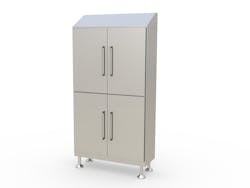Aseptic processing experts will tell you that people are dirty. Any human interaction into a process introduces a greater potential for contamination. In most situations, of course, that’s just not feasible, and so manufacturers continue to improve aseptic methods and cleanroom standards.
Just as the use of disposable equipment is one way they’re doing so, they’re also increasingly looking to disposable gowns and other apparel. As with manufacturing processes, gowning procedures can involve degrees of variability, and transitioning to disposable gowns is one way to reduce this risk, says Damon Larkin, senior professional and category manager in the scientific business at Kimberly-Clark Professional.
“Most sterile facilities will opt for disposable garments due to potential contamination concerns related to reusable garments returned from laundering facilities,” Larkin says. “Disposables eliminate the need for repeat washing, packing and sterilization, all of which are variables that can impact contamination control.”
In an effort to be clean and green, Kimberly-Clark recently formed a partnership with TerraCycle, an “upcycling” company. TerraCycle collects used garments, converts and resells them as either bulk plastics or consumer products. A barcode system allows Kimberly-Clark to track waste reduction and report results back to clients.
Moving from traditional to disposable apparel involves an orchestrated transition, says Larkin, with various parties involved. “It’s important to create an implementation plan that establishes who will be involved and assigns specific responsibilities,” he says. The facility’s safety team and safety officers must approve use of the product and ensure it meets EPA or OSHA regulations, while changes to processes are also concerns for regulatory personnel, as they may impact the company’s FDA license.
Next, Quality will play a key role in testing and qualifying the new product, says Larkin. QA must review procedures and process records, test the product to ensure sterility, and approve the final selection based on its data. Meanwhile, QC must inspect all incoming sterile products.
“Most pharmaceutical companies will conduct a new garment validation process for three to nine months,” explains Larkin. During this time the new garments would be worn in a controlled area, though not necessarily in the actual cleanroom in which the garment is designed to be worn. In many companies, he says, “a new sterile gown will also need to undergo testing on three lots before it is validated and approved. In some cases, a change to the standards of practice for that environment will also be required.”
Training workers to don the apparel is the final step, Larkin says. In some companies, cleanroom workers receive training in the new procedures as part of their annual aseptic donning qualification. In order to pass, employees need to demonstrate the donning technique at least three times in a consecutive acceptable manner.
Now that we’re all dressed up, let’s have a look at other new cleanroom products hitting the runways this spring:
Palbam Class, which specializes in cleanroom furniture design and manufacturing, has introduced a new range of 304L stainless steel, electropolished cabinets. Cleanroom cabinets have notoriously been difficult to electropolish, says sales and marketing manager Paul Fenn. Palbam’s design has divided the cabinets into individual parts, making them easier to electropolish and to ship flat-packed, he says. The cabinets are available on either cleanroom casters or leveler legs.
Grieve has introduced an electrically-heated 500°F Class 100 cleanroom cabinet oven, used for drying water from stainless steel and Teflon filter assemblies. The oven’s dimensions are 24” x 36” x 27”. It has four-inch insulated walls and a Type 304, 2B finish stainless steel interior with continuously welded seams. The exterior is finished in white epoxy paint and has a brushed finish stainless steel door cover and control panel face. Safety equipment is included for handling flammable solvents, including explosion venting door hardware. Controls include a digital programming temperature controller and SCR power controller.
ABB Robotics has just introduced an ISO 5 (Class 100) Cleanroom version of the IRB 120, its smallest ever 6-axis robot. The component materials of the original IRB 120 prone to generating particulates have been modified to eliminate the potential for contamination of the manufacturing area and the parts being processed, the company says.
Nilfisk has expanded its line of combustible dust vacuums with the CFM 118/50EXP. It’s designed to collect dry dust and debris that can accumulate on floors and overhead areas in Class I, Group D, and Class II, Groups E, F, and G environments. The vacuum is completely grounded, composed of non-sparking 304 stainless steel, and equipped with conductive hose and accessories to eliminate percussion arcing and static charge, the company says.
ISO 5 cleanroom robots are suited for various pharma material handling and assembly applications. The IRB 120 features a four-layer paint with varnish clearcoat for easy, cloth cleaning, as well as unpainted mounting holes and stainless mechanical stops, and special glue-seals. In certain conditions it can meet more stringent, ISO 4 (Class 10) requirements. More and more, says Joe Campbell, VP of ABB Robots and Applications, manufacturers need a “fast and compact robot that meets stringent anti-contamination requirements.”
The FDA recently cleared Vioguard’s first product, a self-sanitizing computer keyboard. The keyboard uses UV light to automatically clean the surfaces on shared workstations. On a predetermined basis, the keyboard retracts into its own “clean, light-tight enclosure.” It is then flooded with UV light. Users can then wave their hand in front of a motion sensor to open the enclosure and access the sanitized keyboard.
Vioguard claims that the ultraviolet light generated by the keyboard's two 25-watt germicidal fluorescent lamps killed a minimum of 99.99% of harmful bacteria and viruses, including E. coli, MRSA, and other pathogens. The company is gearing the product towards hospitals and clinics, though it has obvious potential for certain lab and cleanroom environments.
Meissner now offers a stainless steel FlexCessory stand to support its FlexFill single-use biocontainers. The stand “provides the luxury of one-handed liquid transfers,” the company says. The stand interfaces with the FlexFill inside a laminar flow hood to facilitate aseptic fluid transfer. Excess fluids can be stored in the biocontainer and on the stand for future use.
It’s not brand new, but the Clean Air Trakker, a cleanroom fogger by Clean Air Solutions, continues to gain traction, says Jim Campbell, company president.
The Trakker uses mega-sonic sound energy and water to produce a fog that enables cleanroom managers to verify fume containment, trace migration paths, and show unidirectional flow, he says. It is made from electropolished 316L stainless steel and packaged in a cleanroom case.






